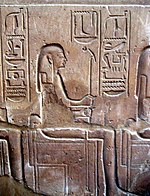Weret-hekau
| Weret-hekau in hieroglyphics | ||||||
|---|---|---|---|---|---|---|
| mostly |
Weret-hekau Wrt-ḥk3w Die an Zauber Große |
|||||
| or |
|
|||||
| Weret-hekau on a relief from Luxor (reign of Ramses II. ) | ||||||
Weret-hekau , also Werethekau , Weret Hekau or Urt-hekau , is an ancient Egyptian goddess in Egyptian mythology . Her name means "The Great in Magic", "Great Sorceress" or "The Magic Realms".
meaning
Already in the pyramid texts the name Weret-hekau is connected with the uraeus snake and the crown of Lower Egypt . As the crown goddess, whose proper name is that of the crowns and tiaras , Weret-hekau usually appears on images of a king's accession to the throne . She leads the king to the god Amun and holds the sign of life ( Ankh ) to his nose. The king in turn offers sacrifices to the goddess. By equating her with the sun's eye and the Uraeus, she became the daughter of the sun god. Weret-hekau is also known as the nickname of various goddesses. Above all Uto , but also the war and lion goddesses Sachmet as well as Renenutet , Mut and Hathor and Isis often bear this name.
presentation
In the later period she appeared as an independent goddess who, like Sachmet, was represented as a woman with a lion's head. Other images also show them with a snake's head or entirely in the shape of a snake. A small shrine from the tomb ( KV62 ) of Tutankhamun contains a cult image of the goddess. Here she is shown as a rearing snake with the head of a woman suckling the king.
See also
literature
- Hans Bonnet : Lexicon of the Egyptian religious history. Nikol, Hamburg 2000, ISBN 3-937872-08-6 , p. 848.
- Richard H. Wilkinson : The world of the gods in ancient Egypt: Faith - Power - Mythology. Theiss, Stuttgart 2003, ISBN 3-8062-1819-6 , p. 228.
